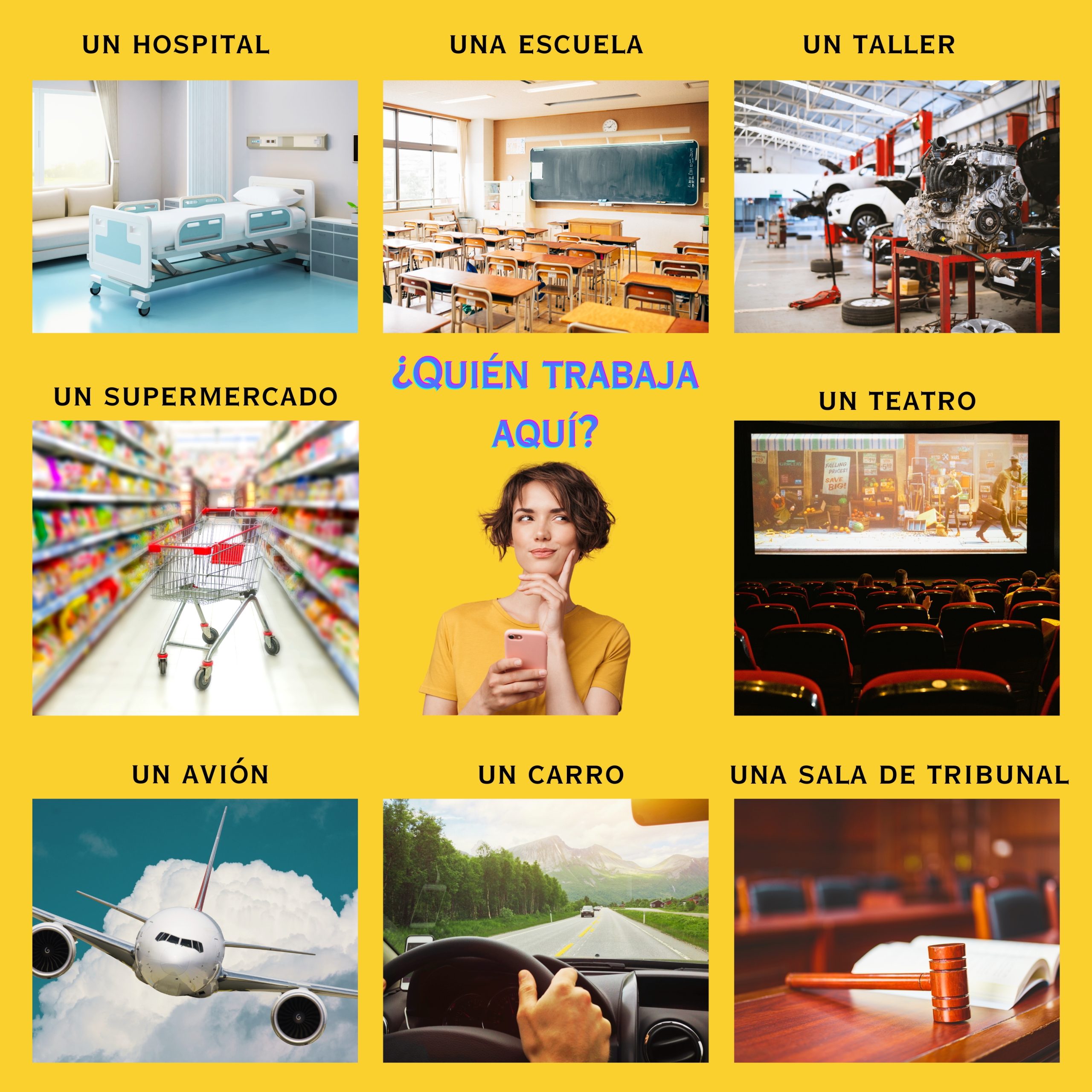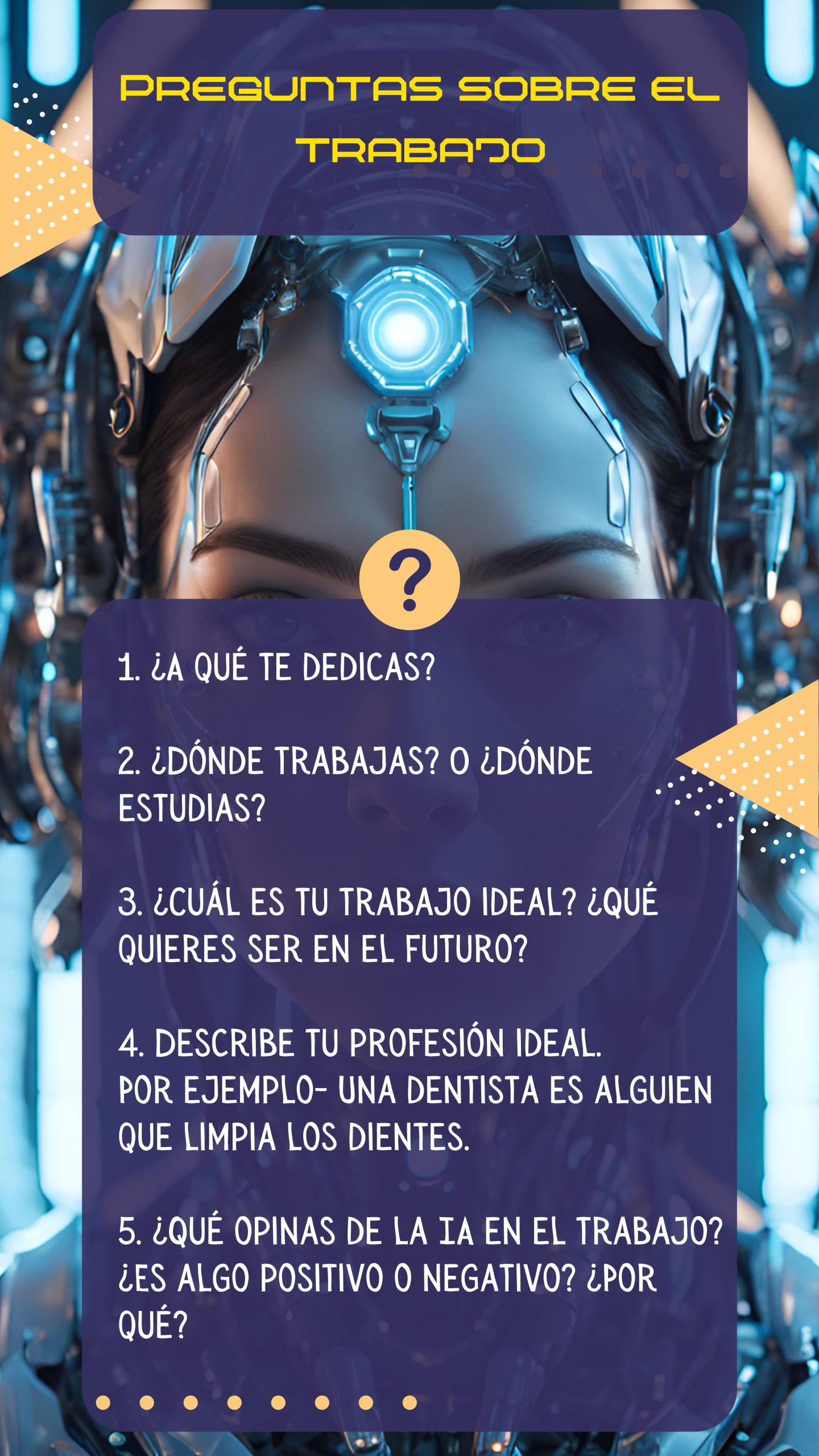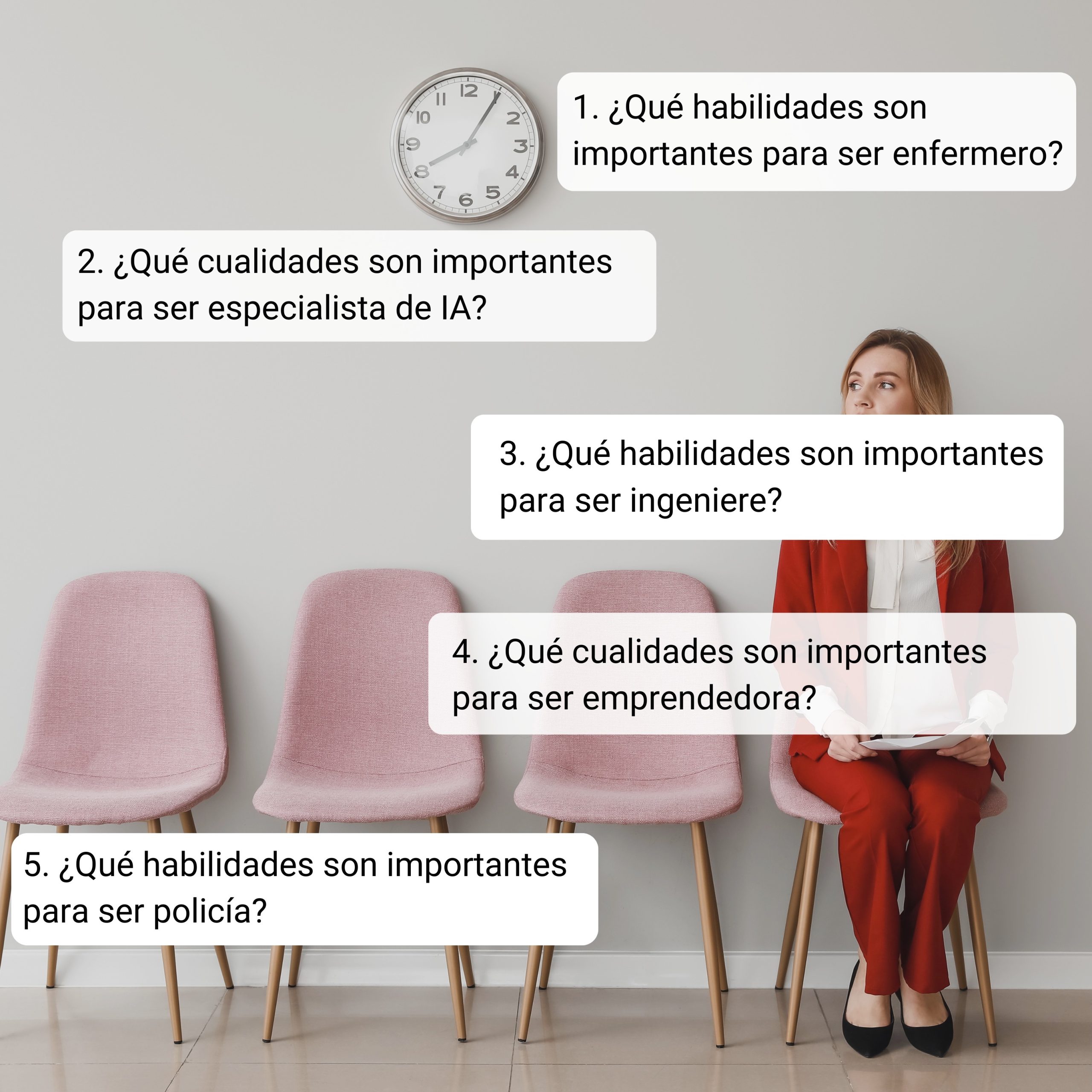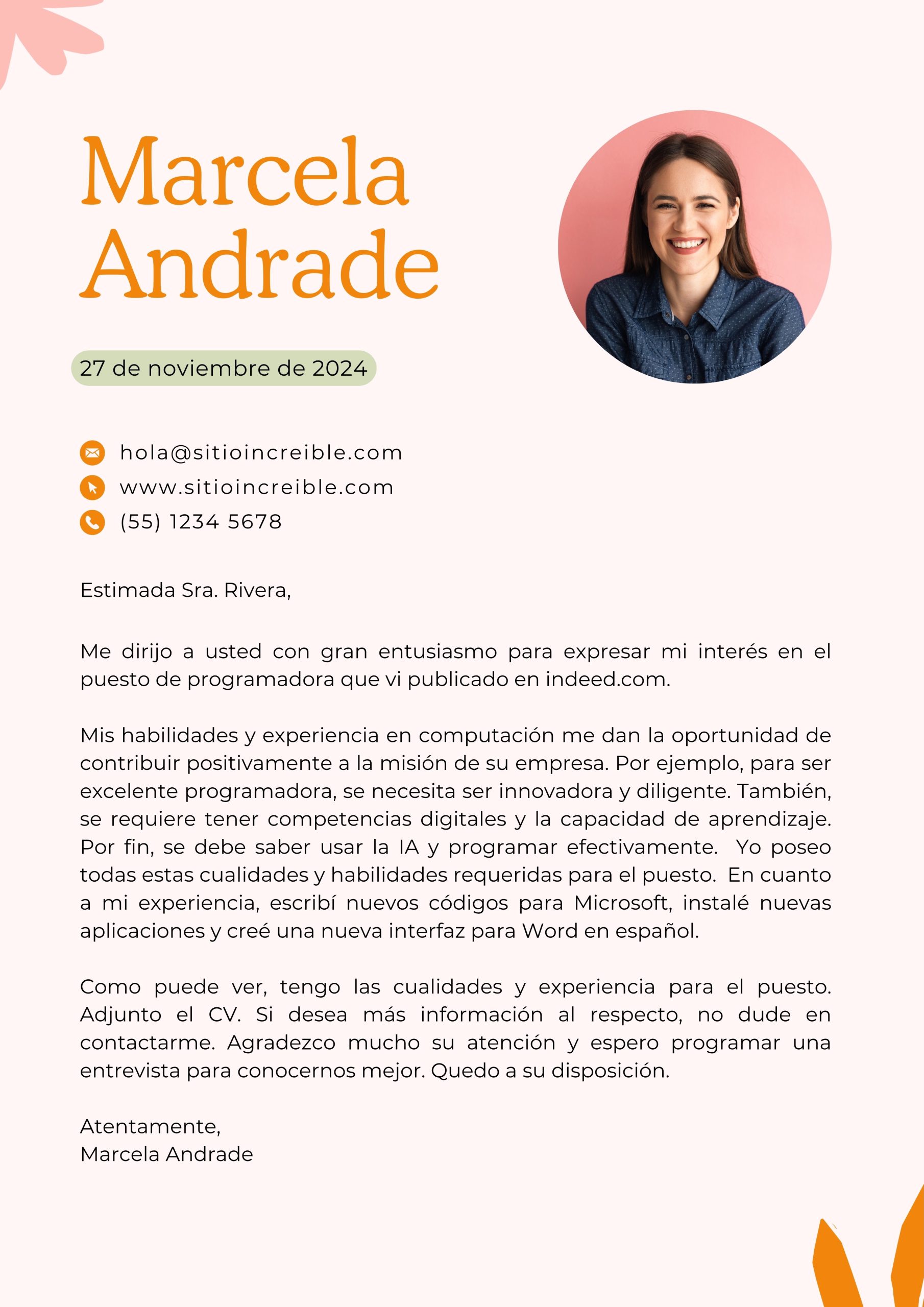9 ¿Cuál es tu trabajo ideal?
Your Chapter 9 task is to describe your ideal job and ask others about theirs.
In this chapter you will learn:
- ¿Cuál es tu trabajo ideal?– to discuss present and future professions and describe them with the relative pronoun que (that)
- ¿Cuál fue tu último trabajo?– to describe your last job or previous studies using the preterit and imperfect tenses
- ¿Qué cualidades se necesita?– to state the qualities one needs or are required for an ideal job using the impersonal and passive se
- La carta de presentación– how to write a cover letter when applying for your dream job
I. ¿Cuál es tu trabajo ideal?
Raise your hand if you work part-time (trabajo de tiempo parcial) or if you work full-time (trabajo de tiempo completo).
You would say: Sí, trabajo de tiempo parcial. OR Sí, trabajo de tiempo completo. OR No trabajo. Soy estudiante.

Now raise your hand if you know what you want to be professionally.
Finally, raise your hand if your ideal profession is one that AI could replace or influence in the present or future.
Intercultural reflection 1
AI has become prominent in many facets of life, such as social, medical, political and professional. Do you feel AI contributes positively or negatively to society? Could all jobs be replaced by AI in the future? If not, which ones could never be replaced by AI and why?
In Spanish, AI is called IA (Inteligencia Artificial). Watch as Doctor Negrete shares the 5 professions that AI cannot replace today, according to AI itself.
Press CC for captions in the language you prefer.
Explore more
1. Do you remember the 5 professions that cannot be replaced by AI, according to Doctor Negrete?
2. Do you agree with the list? Are there any professions you would like to add that were not on the list? Do you fear AI will take over most jobs in the future? How soon could this happen? Is it happening now? Provide some examples.
3. What are some positive contributions AI has made in the workplace? What are some negative ones?
4. Is it too farfetched to see AI robots replacing humans in the workforce? Why or why not?
Recently, a new film, Subservience, featuring Megan Fox as an AI Sim, was released. This film may not be appropriate to watch due to its content, but it does include a very polemic topic of using robots to help alleviate home and work duties for humans.
Watch as Efréstico, a film enthusiast, discusses the film in Spanish. Press CC to choose captions in the language you prefer.
Initially, the film, Subservience, may seem too futuristic and unrealistic. However, recently Elon Musk presented his AI robot, Optimus-Gen 2 to the world.
Kim Kardashian was filmed interacting with the Optimus Gen 2 robot, according to E! News.
How does this interaction make you feel?
5. After watching Efréstico and the Optimus Gen 2 videos, how do you feel now about where AI is heading, especially regarding their role in the home and workplace? Has your opinion changed?
The topic of professions, AI and the future is an interesting one. You were first introduced to professions in Chapter 2, and then again in the Chapter 6 Review in Nepantla.
Do you remember how to ask someone what they do for a living?

¡Correcto! 🙂 ¿A qué te dedicas? is the most common way of asking someone about their profession.
See the following slide for more questions you could ask someone about their job or where they work. You will also learn how to ask someone what their ideal or dream job is, and you will discuss the role gender plays in identifying professions in Spanish.
Press the audio to hear how the questions about professions are pronounced.
Actividad A
Based on the slide you just reviewed, answer the following questions.
What do you do for a living? What do your friends or family do? To begin to describe your profession or someone else’s, it’s important to know how to say various professions in Spanish.
StoryLearning Spanish describes some common occupations in Spanish. Are you interested in pursuing any of them? 🙂
Computrabajo listed the most sought after professions in 2023. Are you studying to enter any of these fields?
@computrabajo ¿Sabes cuáles son las profesiones más demandadas en 2023? 🚀 Te lo contamos 👆 #empleo #trabajo #profesiones #buscartrabajo #computrabajo #fyp
Listen as Spanish Marks introduces you to several occupations in Spanish as well.
Watch as IncluSeñas from Perú demonstrates how to sign common professions in Spanish on TikTok.
For a more comprehensive list of professions in Spanish, see the following slide. Luna, your AI assistant pronounces each of them for you.
Live Lingua also published a list of 99 popular occupations in Spanish. Click here to view them.
If your ideal job or profession is not in the video by Spanish Marks, the slides, or in Live Lingua’s list, feel free to look up your profession at www.wordrerence.com.
Easy Spanish, asked people what they do for a living and whether it was their dream job in Spanish. Watch the first two minutes of the video.
Are any of the speakers in your ideal profession?
Feel free to watch the rest of the video, if you are interested.
Actividad B
¡Muy bien! 🙂
Actividad C
Paso 1. You learned several new occupations. See if you could name where each of the following professionals work.
- Une enfermere
- Un abogado
- Un conductor de Uber
- Una maestra
- Un cajero
- Una mecánica
- Une pilote
- Una actriz
Modelo- Una profesora es alguien que trabaja en una universidad.

Paso 2. Discuss your current profession with another student. If you have a job, state what you do and where you work. If not, you can state what you study and where. Follow the model for the conversation prompt.
Modelo-
Student A- ¿A qué te dedicas? ¿Dónde trabajas?
Student B- No trabajo, pero estudio química en la Universidad de Illinois. OR Soy cajera en un supermercado cerca de mi casa.
¡Excelente! 🙂
Actividad D
Fernanda from Colombia is sharing what she does for a living and where she works. Fernanda is also interested in what you do and what your professional aspirations are. Record your answers to her questions. You could review this slide before answering.
For a transcript of Fernanda’s introduction, click here. Scroll to Fernanda.
¡Excelente! 🙂
If someone wanted to know more about your present or future profession, how would you describe it? For example, what does a person in your current or desired field do?
To answer this question, you could simply say: Un mesero sirve comida y bebidas a la gente.
You could also answer the question by stating what someone does in that field using the relative pronoun, que, which means that, which or who.
Listen as Luna’s friend, Nuria, another AI assistant, defines what a relative pronoun is and how to use it to describe professions.
Nuria introduces what a relative pronoun is in English.
Nuria provides examples of the relative pronoun, que, to describe professions in Spanish.
Actividad E
Luna, your original AI assistant, is following Nuria’s lead by describing some of the professions you learned about in the video and slides thus far.

Luna would like to see if you could correctly guess each occupation she is describing with the relative pronoun que.
¡Muy bien!
Actividad F
Earlier in Nepantla, you played ¿Este o ese?, which is This or That? You will play it again in groups of two. 🙂 You will each decide which profession you would like to describe from the set of pictures you are presented. Once you choose, ¿Este o ese?, use the relative pronoun que to describe what someone does in that profession.
Modelo- You are presented with two cards. One is a dentist (este) and the other is an athlete (ese). You choose to describe the athlete, so you say: Voy a describir ese. Then state your description: Un atleta es alguien que juega deportes profesionalmente.
Your partner goes to the next set of pictures and chooses which one they would like to describe. You should each be describing 3 different professions in Spanish.
¡Excelente! 🙂
You learned that certain professions in Spanish do not have a feminine form, such as soldado, piloto or camionero (bus driver). Do you remember the ways to identify women in these professions?
Intercultural reflection 2
Recently, Mexican actress, Salma Hayek, took on the professional role of producer for her new television series on Max, Like Water for Chocolate (Como agua para chocolate), based on Laura Esquivel’s novel with the same name.
The series takes place in northern Mexico during the Mexican Revolution in the early 1900s. Tita, the main protagonist, is the youngest daughter of three, and because of this, she is not allowed to marry, have children, and must care for her mother until she dies, per their family’s tradition. Tita is also the family cook.
Tita is in love with Pedro, and he loves her as well. Pedro asks for her hand in marriage, but Tita’s mother refuses and offers her eldest daughter, Rosaura, to marry Pedro instead. Pedro accepts this because in his eyes, this is his only way to be close to Tita, who he really loves.
Watch as Fernanda Cortes provides a more historical summary of Como agua para chocolate, the series.
@fernandacortesx A love story steeped in history, ALL episodes of #ComoAguaParaChocolate are now streaming on Max! #MaxPartner #LikeWaterForChocolate 🍫❤️
To see the actual trailer of Salma Hayek’s television series, Como agua para chocolate, play the video below.
Explore more
1. Are you familiar with the book, film or television series, Like Water for Chocolate? Is this a series you would want to watch? Why or why not?
2. The book and the series challenge traditional gender roles in the household and in professions. For example, Tita’s sister, Gertrudis, is a soldier, a profession that still does not have a feminine form to the word. Mamá Elena, Tita’s mom, is the manager of her ranch and carries a weapon, when this position is usually held by a man, especially during that time period.
Why do you feel it is important to show women as soldiers and heads of estates or ranches in film or television, especially in Mexico? Are there any films or tv shows in your culture that challenge gender roles in the household or in professions? If so, what are they, and how are these gender roles challenged?
3. The following characters in the film have specific jobs. Write what each one does in Spanish. Remember the rules about articles and gender in professions you learned earlier in this chapter. For a review, click here.
If you don’t know the name of a certain profession, you could look it up on www.wordreference.com.
Tita is a cook.
Señor Brown is a doctor.
Gertrudis is a soldier.
Rosaura is a housewife.
Mamá Elena is a ranch manager.
Chencha is a maid.
4. Choose 3 of the professions and describe them using the relative pronoun, que.
Modelo- La ama de casa es alguien que limpia la casa y ayuda a la familia.
5. Which character do you think has the hardest profession and why?
6. If you would like to read, Como agua para chocolate, you can search for the book at your local library or purchase it online in English or Spanish. If you would like to watch the series, you should visit Max. There is also a film from 1992, directed by Alfono Arua, with the same name, Cómo agua para chocolate. The film was nominated for a Golden Globe for Best Foreign Language Film.
Now that you have the vocabulary and tools to discuss present and future professions, take turns asking different students about their current jobs and professional aspirations.
Actividad G
Paso 1. Choose 5 different students and ask them one question from the list below.

Paso 2. Write a paragraph of 5 sentences describing what you learned about your classmates’ current and future professions.
Modelo- Magdalena es estudiante. Horacio trabaja en un restaurante. Cherie quiere ser enfermera en su futuro. Ned es maestro. Es alguien que enseña y ayuda a sus estudiantes. Jerome piensa que la IA es algo negativo en el trabajo porque las personas pueden perder su trabajo.
¡Bravo! 🙂
II. ¿Cuál fue tu último trabajo?
You just discussed your present and ideal profession in the future. What about the past? If you were to be interviewed about your last job, how would you answer questions such as: What was your last job? What did you do? Why did you leave?

Listen as Marcos describes his last job, what he did and why he left it using the preterit and imperfect tenses.
For a transcript of Marcos’s video, click here. Scroll to Marcos.
Actividad H
Based on Marcos’s video, answer the following questions about his former job. Include accents in your answers, if necessary.
Do you remember the rules of when to use the preterit and imperfect tenses from the last chapter? If not, please review the following slides as a recap.
Adela just shared some pictures from her former job at a café. Listen as she provides details about what she did, what she would wear to work and what her coffee was like using the preterit and imperfect tenses in context.
Actividad I
In groups of 3-4, discuss why the preterit or imperfect was used in each frame of Adela’s storyboard.
The options for el pretérito would be: una acción completada, una secuencia de acciones en el pasado, acciones que ocurrieron durante un tiempo específico, una acción que interrumpe otra acción en progreso o el comienzo o fin de una acción
The options for el imperfecto would be: una acción habitual en el pasado, una descripción en el pasado, habla de la hora, el clima, edad o emociones en el pasado, una acción en progreso en el pasado
Modelo- En cuadro uno, Adela usa el pretérito porque es una acción completada.
The 2nd slide includes the answers so you could check your work.
¡Excelente! 🙂
Actividad J
In your same groups, describe what Jessica did yesterday using the preterit and imperfect tenses. You could decide if each frame warrants the preterit or imperfect tense.
Because you will be describing Jessica, be sure to use the 3rd personal singular form of the preterit. See the following review.
Pretérito: Forma ella: AR verbs end in ó, ER/IR verbs end in ió, Irregular verbs: fue, estuvo, hizo, vino, vio, dio, dijo, pudo, tuvo
Imperfecto: Forma ella: AR verbs end in aba, ER/IR verbs end in ía, Irregular verbs: era, iba and veía
Modelo-
If I wanted to use the preterit, I could say: En cuadro 1, Jessica se levantó a las siete de la mañana.
If I wanted to use the imperfect, I could say: En cuadro 1, Jessica se sentía muy cansada en su cama.
Your group will decide which tense to use in each frame based on the context you provide. 🙂
Your creativity is inspiring. 🙂
At the end of this chapter, Luna, your AI assistant, will be asking you about your last job or former studies. However, Luna would like you to become more comfortable speaking in the past. So, she prepared practice questions for you.
Respond to each of Luna’s questions using the preterit and imperfect tenses. Hint- the tense you should use in your answer is embedded in each question.
Actividad K
III. ¿Qué cualidades se necesita?
Are there specific qualities or skills one should have for certain professions? For example, what skills are required to be a nurse or a teacher?
To express the qualities needed for particular occupations, you will use the impersonal and passive se. However, first, it’s important to learn what aptitudes or abilities are important for different jobs.
In Spanish, there are two types of skills required for professions. They are called habilidades blandas (interpersonal skills) and habilidades duras (technical skills).
Watch as Grupo Formarte describes what habilidades blandas are and shares examples of the most sought after in a job interview.
You could press CC for captions in the language you prefer.
Actividad L
After watching the video on soft skills, select which ones Grupo Formarte mentioned in their video.
The following video by Global Human Group introduces habilidades duras (technical or specialized skills) and more habilidades blandas (personal or interpersonal skills).
Press CC for captions in the language you prefer.
Actividad M
Place the following soft and hard skills in their respective categories, based on the video you just viewed by the Global Human Group.
¡Muy bien hecho! 🙂
For a complete list of soft and hard skills needed when applying for your dream job, please see the following slides. For the English translation, click on the second slide. Luna pronounces each of the qualities for you in Spanish.
Las cualidades y habilidades con SER
Las cualidades y habilidades con TENER
Las cualidades y habilidades con SABER
The adjectives under the verb ser in the first slide are written in the masculine singular form. You will need adjective agreement if you are describing a quality related to a woman, more than one person or for those that identify as non-binary.
For example: Para ser consejere, es importante ser compasive y saber escuchar activamente. Para ser pilota, es importante ser puntual y organizada.
Actividad N
Select the quality or skill that is important to have in each profession. Although you may feel each quality or skill is valuable for the following occupations, choose the ones that are more significant to have in each.
Actividad O
Paso 1. Ask 5 different students what qualities they deem as important to have for each of the following professions. You could access the qualities by reviewing them in the blue slide.
Modelo- Hola, Jimmy. ¿Qué habilidades son importantes para ser enfermero?
Jimmy answers: Para ser enfermero, es importante ser paciente y tener empatía.

Paso 2. What qualities or skills are important in your ideal job? Choose 3, and complete the following sentence. Try to choose a quality from each category in the blue slide.
Modelo- Para ser profesora, es importante ser apasionada, tener el don de gentes y saber resolver problemas.
Para ser _______, es importante ser _____, tener _____ y saber _______.
Another way to express qualities or skills needed in a particular occupation is with the impersonal and passive se.
Listen as Mónica, an entrepreneur looking to hire an assistant, describes what qualities one should have or are needed to fill the position. The second slide includes the qualities in English.
Do you agree with Mónica’s list?
Mónica uses both the impersonal and passive se to express the qualities needed to fill the assistant’s position. What is the impersonal se? What is the passive se?
Watch as Natasha describes what the impersonal and passive se are and how to use them in conversation about ideal jobs or positions candidates are looking to fill.
For a visual summary of Natasha’s explanation of the impersonal and passive se, see the following slide.
Actividad P
Select whether each statement about ideal candidates is written with the se impersonal or se pasivo.
¡Perfecto! 🙂
Actividad Q
Revisit Mónica’s list of qualities one needs to fill her assistant’s position in Spanish and English. Then place whether each statement belongs in the se impersonal or se pasivo category.
How did you do? 🙂

Actividad R
It’s time to discuss the qualities that are needed for your future profession! 🙂

Paso 1. Write a sentence in the se impersonal and one in the se pasivo listing which qualities one should have and are needed to for your ideal job. Then write what each means in English. To review the qualities, click here. Go to the pink slide.
Modelo-
Para ser psicólogo, se debe escuchar activamente y ser paciente. (Se impersonal- To be a psychologist, one should know how to listen actively and be patient.)
Para ser psicólogo, se requiere saber cómo pensar críticamente y ser positivo. (Se pasivo- To be a psychologist, knowing how to think critically and being positive are required.)
Paso 2. Read your sentences to a classmate.
Did your ideal professions have any qualities or skills in common?
IV. La carta de presentación
You’ve learned how to express your ideal job, what someone in that job does with the relative pronoun que, what you did in your last job using the preterit and imperfect tenses, and the qualities and skills needed in your dream profession using the se impersonal and se pasivo. ¡Excelente! 🙂
You will now be given an opportunity to include everything you learned in this chapter in a cover letter in Spanish to an employer you would like to work for in the future. How exciting! 🙂
This task will serve you in your professional future when you seek employment in your ideal occupation.
In Spanish, a cover letter is called una carta de presentación. Watch as Fátima Sesé from ISPROX introduces you to how to write an effective cover letter in Spanish.
Press CC for captions in the language you prefer.
Actividad S
Based on Fátima’s video, answer the following questions about la carta de presentación.
To structure your cover letter, use the guide in the following slides. You will see the Spanish and English versions.
Because you do not yet know your future employer’s address and to maintain your own privacy, you will exclude the addresses in your cover letter.
See the following example of la carta de presentación. Some cover letters have become more modern and creative.

If you would like to see examples of more cover letters in Spanish, here are some from Job Seeker. Click here.
Now that you have the tools to write your cover letter in Spanish, are you ready to write your own?
The song playing in the background is called “Mi Tesoro” by Zion & Lennox.
Your instructor will provide details about how to submit your cover letter.
V. Chapter 9 Final Assessment
In Chapter 9, you learned how to discuss current, past and future professions and ask others about theirs. You also wrote your first cover letter in Spanish. ¡Muy bien! 🙂
For your Chapter 9 Final Assessment, Luna would like to converse with you about your job experience and professional goals.

